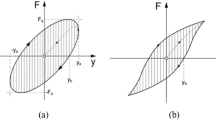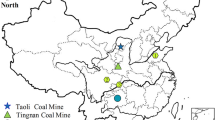Abstract
Characterization of bituminous coal is carried out to evaluate the behaviour of coal when it is subjected to different loading or stress conditions such as tensile stress, shear stress and normal stress. Index properties such as microstructure of geomaterial, density, porosity, specific gravity, water absorption, colour and formation that form a set of intrinsic properties have been evaluated and used to classify the bituminous coal. Mechanical properties have been evaluated based on strength characteristics such as quasi-static uniaxial compressive strength, shear strength, and tensile strength and other derived parameters such as normal stress, shear stress, deformation, elastic modulus, shear modulus, maximum stretching hydrostatic pressure, normalized cohesive strength, internal angle of friction, normalized pressure hardening coefficient, pressure hardening index, strain rate coefficient, maximum normalized intensity and damage parameters. Numerous material characterisation tests have been performed on bituminous coal to determine the above-mentioned parameters such as triaxial shear tests, large direct shear tests, uniaxial compression tests, split tensile strength tests, water absorption tests, porosity test and X-ray diffraction. Numerical methods have proven to be an important tool in the design and evaluation of safety in mines without involving cumbersome experimental analysis procedures. Finite element-based Software Abaqus has been employed using Holmquist Johnson and Cook model to validate and characterize the constitutive characteristics of bituminous coal. Numerical results of different strength aspects obtained through the study have been found in good agreement with the experimental results having an overall variation in results of less than 15%.































Similar content being viewed by others
Abbreviations
- XRD :
-
X-ray diffraction
- HJC :
-
Holmquist Johnson Cook
- SEM :
-
Scanning electron microscope
- EDS :
-
Energy dispersive X-ray spectroscopy
- C :
-
Cohesion
- ϕ :
-
Internal angle of friction
- µ :
-
Poisson’s ratio
- E :
-
Modulus of Elasticity
- G :
-
Modulus of Rigidity
- K :
-
Bulk Modulus
- σ :
-
Stress
- ε :
-
Strain
- ρ 0 :
-
Density
- G :
-
Shear modulus
- f c :
-
Quasi-static uniaxial compressive strength
- T :
-
Maximum stretching hydrostatic pressure
- A :
-
Normalized cohesive strength
- B :
-
Normalized pressure hardening coefficient
- N :
-
Pressure hardening index
- C :
-
Strain rate coefficient
- S max :
-
Maximum normalized intensity
- p C :
-
Volumetric pressure at crushing point
- µ C :
-
Volumetric strain at crushing point
- p l :
-
Pressure at compaction point
- µ l :
-
Volumetric strain at compaction point
- k 1 :
-
Pressure constant
- k 2 :
-
Pressure constant
- k 3 :
-
Pressure constant
- ε f min :
-
Minimum plastic strain at the material failure point
- D1:
-
Damage parameter
- D2:
-
Damage parameter
- ε˚ :
-
Reference strain rate
- f S :
-
Failure type
References
Liu Y, Li S, Tang D, Xu H, Tao S and Hu X 2019 Mechanical behaviour of low-rank bituminous coal under compression: An experimental and numerical study. J. Nat. Gas Sci. Eng. 66: 77–85. https://doi.org/10.1016/j.jngse.2019.03.012
Lu J, Yin G, Zhang D, Gao H and Li C 2020 True triaxial strength and failure characteristics of cubic coal and sandstone under different loading paths. Int. J. Rock Mech. Min. Sci. 135: 1–15. https://doi.org/10.1016/j.ijrmms.2020.104439
Xie H, Ju Y, Gao F, Gao M and Zhang R 2017 Groundbreaking theoretical and technical conceptualization of fluidized mining of deep underground solid mineral resources. Tunnel. Undergr. Space Technol. 67: 68–70. https://doi.org/10.1016/j.tust.2017.04.021
Chamn O, Kang S G, Graham K, Sarofm F and Beer J M 2006 Variation in Coal Composition. Depart. Chem. Eng. Massachusetts Inst. Technol. Camb. MA 02139 (U.S.A. ). 302–616. https://doi.org/10.17226/11977
Annual Coal Report (2019) 2020 U.S. Energy Information Administration., Washington, DC 20585. 1–69
Coal: Research and Development to Support National Energy Policy 2007 National Research Council: Washington, DC. 1–170. https://doi.org/10.17226/11977
Szpor A and Konstancja Z 2018 GSI report on the transformation of the Polish coal sector international institute for sustainable development. International Institute for Sustainable Development, Manitoba, Canada.1–25. www.iisd.org/gsi
Xie B, Yan Z, Du Y, Zhao Z and Zhang X 2019 Determination of Holmquist–Johnson–Cook constitutive parameters of coal: Laboratory study and numerical simulation. MDPI Process. 7(6): 1–20. https://doi.org/10.3390/PR7060386
Manoj B 2016 A comprehensive analysis of various structural parameters of Indian coals with the aid of advanced analytical tools. Int. J. Coal Sci. Technol. 3(2): 123–132. https://doi.org/10.1007/s40789-016-0134-1
Wu Z and Steel K M 2007 Demineralization of a UK bituminous coal using HF and ferric ions. Fuel. 86: 2194–2200. https://doi.org/10.1016/j.fuel.2007.02.038
Zhao P, Tan X, Schmidt M, Wei A, Huang W and Qian X 2020 Minimum explosion concentration of coal dusts in air with small amount of CH4, H2, CO under 10-kJ ignition energy conditions. Fuel. 260: 1–24. https://doi.org/10.1016/j.fuel.2019.116401
Liew M, Xiao M and Liu S 2021 Characterization of physical and mineralogical properties of anthracite and bituminous coal tailings. Int. J. Coal Preparat. Utiliz. 41(9): 645–660
Ebnesajjad S 2011 Surface and material characterization techniques. Handb. Adhes. Surface Prepar.. https://doi.org/10.1016/B978-1-4377-4461-3.10004-5
IS: 2720 (part 11) 1993 Determination of the shear strength parameters of a specimen tested in Unconsolidated Undrained triaxial compression without the measurement of pore water pressure. Bureau of Indian Standards, New Delhi, India
Nie W, Peng S J, Xu J, Liu L R, Wang G and Geng J B 2014 Experimental analyses of the major parameters affecting the intensity of outbursts of coal and gas. Sci. World J. Hindawi Publ. 2014: 1–9. https://doi.org/10.1155/2014/185608
Liu R, Yu Y, Cheng W, Xu Q, Yang H and Shen J 2020 Comparative analyses concerning triaxial compressive yield criteria of coal with the presence of pore water. Geofluids Hindawi. 2020: 1–15. https://doi.org/10.1155/2020/4670812
Zhang Y, Yang Y and Ma D 2020 Mechanical characteristics of coal samples under triaxial unloading pressure with different test paths. Shock Vibr. Hindawi. 2020: 1–10. https://doi.org/10.1155/2020/8870821
Zhou Y, Liu C and Ma D 2019 Method improvement and effect analysis of triaxial compression acoustic emission test for coal and rock. Adv. Civ. Eng. Hindawi. 2019: 1–10. https://doi.org/10.1155/2019/8910362
Chen D, Guo Z, Huang H, Sun B, Lu H and Zhu W 2019 Triaxial test of coal-rock under effective confining pressure. IOP Conf. Ser. Mater. Sci. Eng. 592: 1–6. https://doi.org/10.1088/1757-899X/592/1/012175
IS 5816 1999 Indian standard Splitting tensile strength of concrete- method of test. Bureau of Indian Standards, New Delhi
Tahmasebinia F, Zhang C, Canbulat I, Vardar O and Saydam S 2018 Computing the damage and fracture energy in a coal mass based on joint density. Int. J. Min. Sci. Technol. 28(5): 813–817. https://doi.org/10.1016/j.ijmst.2018.08.013
Evans I and Pomeroyc C D 1966 The strength, fracture and workability of coal. Pergamon Press Ltd., Headington Hll Hall, Oxford, pp 1–304
Ram B B 1985 Mode I fracture toughness of coal. Int. J. Min. Eng. 3: 229–236
Zhang Q 2014 Doctrate Thesis Summary Mechanical Behaviour of Rock Materials under Dynamic Loading. Swiss Federal Institute of Technology in Lausanne, 1–39
Zhao Y and Yaodong G Z 2013 Experimental and numerical modelling investigation on fracturing in coal under impact loads. Int. J. Fracture 183: 63–80. https://doi.org/10.1007/s10704-013-9876-6
IS 12634 1989 Method of determination for direct shear strength of rock joints. Bureau of Indian Standards, New Delhi, India
Li W, Bai J, Cheng J, Peng S and Liu H 2015 Determination of coal-rock interface strength by laboratory direct shear tests under constant normal load. Int. J. Rock Mech. Min. Sci. 77: 60–67. https://doi.org/10.1016/j.ijrmms.2015.03.033
Williams D J and Kho A K 2013 Settlement and shear strength of uncemented coal mine overburden materials placed loose under dry and wet conditions. Proceedings of the 18th International Conference on Soil Mechanics and Geotechnical Engineering Paris, 441–444
IS:1124–1974 2003 Method of test for determination of water absorption, apparent specific gravity and porosity of natural building stones. Bureau of Indian Standards, India
Author information
Authors and Affiliations
Corresponding author
Rights and permissions
About this article
Cite this article
Bhat, I., Rupali, S. & Kumar, A. Experimental and numerical analysis of constitutive characteristics in bituminous coal. Sādhanā 47, 159 (2022). https://doi.org/10.1007/s12046-022-01911-5
Received:
Revised:
Accepted:
Published:
DOI: https://doi.org/10.1007/s12046-022-01911-5




